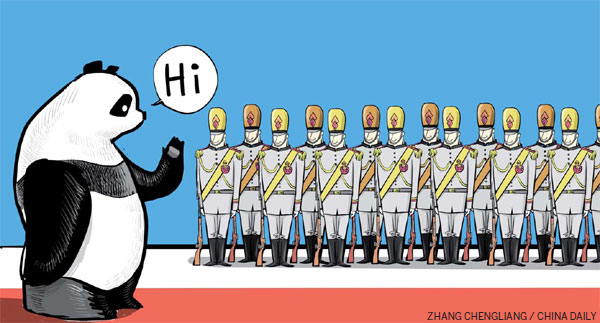Mother Nature's messenger


China's most popular diplomat is now issuing an urgent warning to the world
In 1941, the critical year of World War II, Madame Chiang Kai-shek (Soong May-Ling) gave an unusual gift to the Americans in appreciation of the help they gave China. It was the first time that a modern Chinese government had delivered such a gift, and China won a staunch ally.
In 1972, after president Richard Nixon's historic visit to China, the Chinese government gave the same gift to the American people. It was regarded as a roaring diplomatic success and evidence of China's eagerness to establish official relations with the United States.
The gifts, of course, were giant pandas, which have been considered a priceless gift to any country. Extraordinary VIP treatment has been given to all those delightful emissaries. In 1972, Japan sent two aircraft to escort a pair of giant pandas when the aircraft carrying them entered Japan's airspace. West Germany rolled out the red carpet for a pair two years later.
These marked the first cross-cultural exchanges between the People's Republic of China and the West, and this practice has become known as panda diplomacy. China sent 23 pandas to nine countries from 1957 to 1983, and although in 1984 the Chinese changed their policy of giving away pandas to one of leasing them, no diplomats could be more popular or successful as giant pandas.

As goodwill ambassadors, pandas' value in diplomacy did not start in modern times. According to the Japanese Royal Annual, in AD 658 Empress Wu Zetian of the Tang Dynasty presented to Japanese Emperor Temmu a pair of bears, which modern researchers believe were pandas. We should not be surprised that in ancient history those diplomatic gifts were referred to as bears as the panda (Ailuropoda melanoleuca) is a type of bear with the body shape typical of most of the species.
Having held the position of China's ambassador of goodwill to the world for more than 1,000 years, recently the panda was sent back to China by Hollywood as an animated image. Kung Fu Panda is a 2008 US computer-animated film produced by DreamWorks Animation, directed by John Stevenson and voiced by Jack Black and Dustin Hoffman. The film was extremely well received in China, becoming the first animated film to make more than 100 million yuan ($16.3 million; 11.9 million euros) at the Chinese box office. The fact that such an action comedy film based on Chinese culture was created by the US film industry has led to Chinese introspection. It is that sort of cultural sensitivity that sells tickets.
The film was a surprising success because it ingeniously merges the panda, the most beloved Chinese animal, with the simplest and best-known Chinese characteristics, such as kung fu, noodles, filial piety and youth rebellion. Set in the Valley of Peace, a fictional land in ancient China populated by anthropomorphic animals, the plot centers on a humbling and clumsy panda named Po who aspires to be a kung fu master. His father Mr Ping, owner of a noodle shop, hopes that Po will take over the business that has been in the family for four generations. However, Po is not thrilled by the idea of making noodles for the rest of his life and, instead, takes up kung fu. The filmmakers did not forget to integrate a basic Hollywood plot into the movie, with good defeating evil and the belittled underdog finally triumphing. When it is foretold that the evil kung fu warrior, Tailung, will escape from prison, Po is unintentionally named as the chosen kung fu warrior ordained to bring peace to the land, much to the displeasure of other kung fu warriors. The audience accepted the movie positively because they appreciated the Americans' skillful retelling of Chinese tradition by the typical Hollywood story of a hero's journey. And that hero was their beloved panda, whose appearance always brings a smile to a Chinese face.
Pandas are not only China's ambassadors to the world and, sometimes, the world's ambassadors to China, but they are also nature's messenger. Fragile, with charmingly naive movements, pandas are especially dependent on a clean and green environment. When people love pandas, they consciously or subconsciously love the green and clean environment pandas come from. Furthermore pandas, as endangered animals, also represent an environment threatened by pollution and over-development.
Despite being catalogued as a carnivore, a panda's diet consists almost exclusively of bamboo. About 750 years ago, Marco Polo reported seeing gigantic bamboo forests roamed by wild animals in the Yellow River Valley. The area of wild bamboo has been shrinking for centuries so that now it has become almost extinct in China, and the panda population, whose natural habitat is still the bamboo forest, has reduced in proportion. The only exceptions are areas such as the Sichuan Giant Panda Sanctuaries, but the numbers of wild panda are decreasing every year.
The panda started as a kind of ambassador from China to the West and was adapted by Hollywood to become an export from the West to China, but now the cute and lovable animal carries a grave and urgent message. A message from nature to the human race: protect the environment with all means; otherwise pandas will soon become extinct, and they will be followed by other animals, including human beings.
The author is a professor of Asian languages and literature at Carleton College in Minnesota. The views do not necessarily reflect those of China Daily.
(China Daily Africa Weekly 05/02/2014 page12)
Today's Top News
- China warns Japan against interference
- Nation's euro bond sale shows investors' confidence
- No soft landing for Tokyo's hard line
- Commerce minister urges US to increase areas of cooperation
- Strong demand for China's sovereign bonds signals global confidence
- Ministry urges Japan to 'maintain self-respect'






























